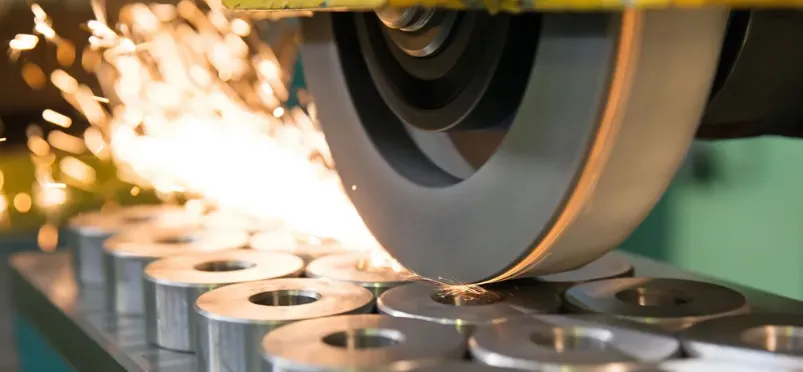Grinding is a fundamental and widespread process in the realm of manufacturing and material processing, characterized by the removal of material from a workpiece through the use of abrasives. This operation goes beyond mere material removal; it plays a critical role in shaping, finishing, and enhancing the properties of various surfaces to ensure they meet stringent specifications necessary for a diverse array of applications across multiple industries, including automotive, aerospace, medical, and general manufacturing. The origins of grinding date back thousands of years, but its evolution into a sophisticated technique has made it an essential component in modern production systems.
 At its core, grinding facilitates the attainment of precise dimensions and superior surface finishes that cannot be achieved through other machining methods. The process encompasses several types, such as surface grinding, cylindrical grinding, and centerless grinding, each designed to accommodate specific tasks and materials. Surface grinding, for instance, involves the use of a flat grinding wheel to produce flat surfaces on metal workpieces, enhancing both their functionality and aesthetic appeal. In contrast, cylindrical grinding is utilized for generating precise cylindrical forms, crucial for components like shafts and sleeves. Centerless grinding offers even more efficiency by allowing continuous rotation of the workpiece, which is held between two wheels, minimizing setup time and improving throughput.
At its core, grinding facilitates the attainment of precise dimensions and superior surface finishes that cannot be achieved through other machining methods. The process encompasses several types, such as surface grinding, cylindrical grinding, and centerless grinding, each designed to accommodate specific tasks and materials. Surface grinding, for instance, involves the use of a flat grinding wheel to produce flat surfaces on metal workpieces, enhancing both their functionality and aesthetic appeal. In contrast, cylindrical grinding is utilized for generating precise cylindrical forms, crucial for components like shafts and sleeves. Centerless grinding offers even more efficiency by allowing continuous rotation of the workpiece, which is held between two wheels, minimizing setup time and improving throughput.

The machinery and technology involved in grinding are vital to its effectiveness. Ranging from simple bench grinders to sophisticated Computer Numerical Control (CNC) machines, the equipment has advanced significantly to improve accuracy and decrease production times. CNC grinders, for example, incorporate computer-based controls to automate the grinding process, allowing for high repeatability and precision required in complex geometries. Additionally, the selection of the appropriate grinding wheel—a crucial element of the grinding process—depends on multiple factors, including the material of the workpiece, the desired finish, and the specific type of grinding operation. Different wheels are made from varied materials, such as aluminum oxide, silicon carbide, and diamond, each suited for particular applications and materials. Grit size also plays a significant role, as coarser grits are suited for material removal, while finer grits are ideal for achieving smooth finishes.
Moreover, the application of coolant during the grinding process cannot be underestimated. Coolants serve to regulate the temperature, reducing heat generated by friction, which can lead to thermal damage to both the workpiece and the grinding wheel itself. Furthermore, they assist in flushing away debris, keeping the grinding surface clear, and prolonging the life of the tools. Various types of coolant—ranging from oils to synthetic fluids—are used based on the specific needs of the grinding operation and the materials involved.
In addition to industrial applications, grinding technology permeates daily life through common devices such as coffee grinders and food processors, illustrating the versatility of the grinding principle. The precision achieved through grinding is indispensable for creating components that require tight tolerances, such as surgical instruments or aerospace parts, where even minute deviations can result in catastrophic failures. This critical need for quality control has propelled the grinding process towards continuous evolution, incorporating automation and digital monitoring systems to enhance productivity. Advanced analytics and machine learning algorithms are increasingly employed to predict tool wear, optimize grinding parameters, and improve overall efficiency, reflecting the ongoing demand for more sophisticated manufacturing processes able to deliver high-quality products in an increasingly competitive global market.
The future of grinding is likely to see even further innovations as industries strive for greater efficiency, sustainability, and automation. New materials and technologies are being developed that promise to enhance grinding performance while reducing environmental impact. The integration of smart technologies into grinding operations can lead to real-time monitoring and adjustment of processes, significantly increasing the reliability and efficacy of the outcomes. As the landscape of manufacturing continues to change, grinding will undoubtedly remain a cornerstone process, essential for achieving precision and quality in a wide range of applications. This ongoing relevance not only highlights the technical intricacies of the grinding process but also underscores its significance in meeting the challenges posed by modern manufacturing demands.







